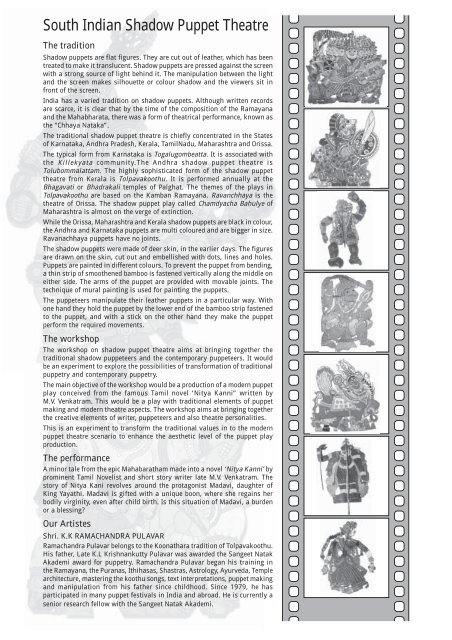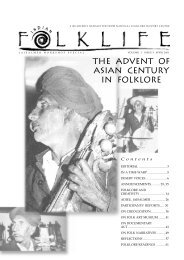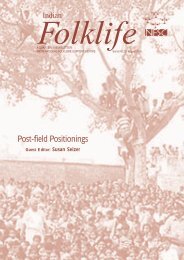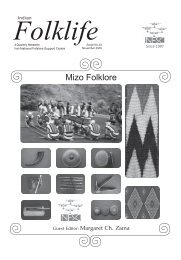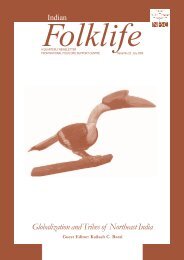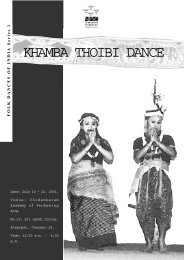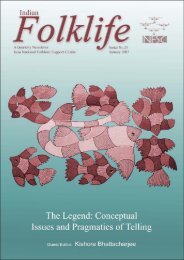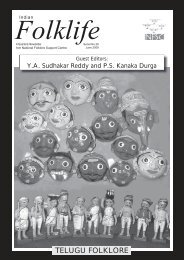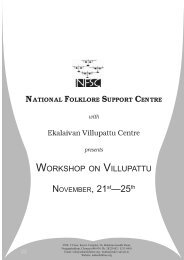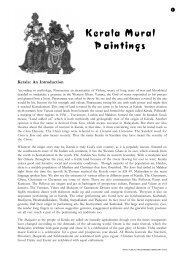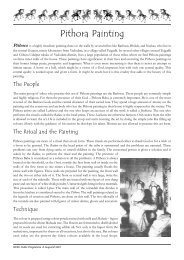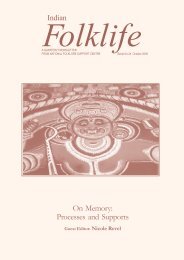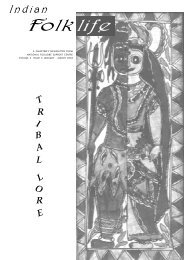South Indian Shadow Puppet Theatre - Wiki - National Folklore ...
South Indian Shadow Puppet Theatre - Wiki - National Folklore ...
South Indian Shadow Puppet Theatre - Wiki - National Folklore ...
You also want an ePaper? Increase the reach of your titles
YUMPU automatically turns print PDFs into web optimized ePapers that Google loves.
<strong>South</strong> <strong>Indian</strong> <strong>Shadow</strong> <strong>Puppet</strong> <strong>Theatre</strong>The tradition<strong>Shadow</strong> puppets are flat figures. They are cut out of leather, which has beentreated to make it translucent. <strong>Shadow</strong> puppets are pressed against the screenwith a strong source of light behind it. The manipulation between the lightand the screen makes silhouette or colour shadow and the viewers sit infront of the screen.India has a varied tradition on shadow puppets. Although written recordsare scarce, it is clear that by the time of the composition of the Ramayanaand the Mahabharata, there was a form of theatrical performance, known asthe “Chhaya Nataka”.The traditional shadow puppet theatre is chiefly concentrated in the Statesof Karnataka, Andhra Pradesh, Kerala, TamilNadu, Maharashtra and Orissa.The typical form from Karnataka is Togalugombeatta. It is associated withthe Killekyata community.The Andhra shadow puppet theatre isTolubommalattam. The highly sophisticated form of the shadow puppettheatre from Kerala is Tolpavakoothu. It is performed annually at theBhagavati or Bhadrakali temples of Palghat. The themes of the plays inTolpavakoothu are based on the Kamban Ramayana. Ravanchhaya is thetheatre of Orissa. The shadow puppet play called Chamdyacha Bahulye ofMaharashtra is almost on the verge of extinction.While the Orissa, Maharashtra and Kerala shadow puppets are black in colour,the Andhra and Karnataka puppets are multi coloured and are bigger in size.Ravanachhaya puppets have no joints.The shadow puppets were made of deer skin, in the earlier days. The figuresare drawn on the skin, cut out and embellished with dots, lines and holes.<strong>Puppet</strong>s are painted in different colours. To prevent the puppet from bending,a thin strip of smoothened bamboo is fastened vertically along the middle oneither side. The arms of the puppet are provided with movable joints. Thetechnique of mural painting is used for painting the puppets.The puppeteers manipulate their leather puppets in a particular way. Withone hand they hold the puppet by the lower end of the bamboo strip fastenedto the puppet, and with a stick on the other hand they make the puppetperform the required movements.The workshopThe workshop on shadow puppet theatre aims at bringing together thetraditional shadow puppeteers and the contemporary puppeteers. It wouldbe an experiment to explore the possibilities of transformation of traditionalpuppetry and contemporary puppetry.The main objective of the workshop would be a production of a modern puppetplay conceived from the famous Tamil novel ‘Nitya Kanni” written byM.V. Venkatram. This would be a play with traditional elements of puppetmaking and modern theatre aspects. The workshop aims at bringing togetherthe creative elements of writer, puppeteers and also theatre personalities.This is an experiment to transform the traditional values in to the modernpuppet theatre scenario to enhance the aesthetic level of the puppet playproduction.The performanceA minor tale from the epic Mahabaratham made into a novel ‘Nitya Kanni’ byprominent Tamil Novelist and short story writer late M.V. Venkatram. Thestory of Nitya Kani revolves around the protagonist Madavi, daughter ofKing Yayathi. Madavi is gifted with a unique boon, where she regains herbodily virginity, even after child birth. Is this situation of Madavi, a burdenor a blessing?Our ArtistesShri. K.K RAMACHANDRA PULAVARRamachandra Pulavar belongs to the Koonathara tradition of Tolpavakoothu.His father, Late K.L Krishnankutty Pulavar was awarded the Sangeet NatakAkademi award for puppetry. Ramachandra Pulavar began his training inthe Ramayana, the Puranas, Ithihasas, Shastras, Astrology, Ayurveda, Templearchitecture, mastering the koothu songs, text interpretations, puppet makingand manipulation from his father since childhood. Since 1979, he hasparticipated in many puppet festivals in India and abroad. He is currently asenior research fellow with the Sangeet Natak Akademi.
Shri. S. CHITHAMBARA RAOChithambara Rao is a tradtional puppeteer from Andhra Pradesh and <strong>National</strong> Award winner for puppetry. He is theDirector of Chaya Nataka Brundam, at Dharmavaram. He comes from a long line of traditional Andhra <strong>Shadow</strong> <strong>Puppet</strong>theatre performances. He has performed in various places in India and abroad.Shri. V. AJITHKUMARV. Ajithkumar is a contemporary puppeteer from Kerala.He has started his career as a puppeteer since 1993. He establishedhis own puppet theatre- Natyadarsana <strong>Puppet</strong> <strong>Theatre</strong> at Calicut in 2000. He has written and directed four innovativepuppet plays with stylized puppets and modern theatre techniques. He is the editor-in charge of a quarterly for puppetry,theatre and folk arts titled “<strong>Puppet</strong>” published from Calicut. Now he is an artiste in residence at NFSC.Exhibition cum saleAn exhibition of leather shadow puppets will be held in the art gallery at <strong>National</strong> <strong>Folklore</strong> Support centre, Chennai fromAugust 22 nd to 29 th , 2005 from 11 am to 5 pm.Workshop ScheduleDate : 22-29 August, 2005 Venue : <strong>National</strong> <strong>Folklore</strong> Support Centre, Chennai Time : 10.00 am to 5.00 pmAug 22Inaugural ceremonyIntroduction and Demonstration of Leather shadowpuppetryInteraction with shadow puppetry artistesManipulation Techniques of leather puppetsStory telling in traditional shadow puppetryVideo Screening: Kambaramayana in TolpavakoothuAug 23Discussion on script: Human theatre and <strong>Puppet</strong>theatreDiscussion on M.V. Venkatram’s Nitya KanniMaking one-line for the puppet playConstruction of puppets beginsSketches for puppetsVideo screening: A documentary about the puppettheatre of KeralaAug 24Script writing workshopFinalising the scriptDiscussion on transforming traditional elements to amodern play with reference to the scriptConstruction of puppets contdVideo screening: Wayang, shadow puppet play ofIndonesiaAug 25Construction: Cut out of heads, body, legs and handsConstruction contdFinalising skeletons of puppetsFixing the body parts according to the anatomy and withpossible movementsVideo screening, <strong>Shadow</strong> play by <strong>Puppet</strong> Lab, ScotlandAug 26Painting methodsMural painting of Kerala and way of painting the puppetPainting the puppetsAug 27Fixing the rod, Finalising puppetsDevices can be used in puppet play, new technology,lighting, music etcVoice modulation/story tellingManipulation training with puppets made byparticipantsAug 29Finalising the productionRehearsalPerformanceValedictory functionBibliographyG. Venu, 1990, Tolpavakoothu-shadow puppets of Kerala, Sangeet Natak akademiG. Venu, <strong>Puppet</strong>ry and lesser known dance traditions of Kerala, NatanakairaliBlackburn, Stuart, 1996, Rama stories and shadow puppets, Oxford University PressRao, M.S. Nanjunda, 2000, Leather puppetry in Karnataka, Karnataka Chithrakala ParishathPani, Jiwan, Ravana Chhaya, sangeet Natak AkademiSarma, M. Nagabhushana, 1985, Tolubommalata, sangeet natak Akademi, New DelhiPani, Jiwan, Living dolls story of <strong>Indian</strong> puppetry, Publication division<strong>National</strong> <strong>Folklore</strong> Support Centre (NFSC) is a non-governmental, non-profit organization registered inChennai dedicated to the promotion of <strong>Indian</strong> folklore research, education, training, networking andpublications. The aim is to integrate scholarship with activism, aesthetic appreciation with communitydevelopment, comparative folklore studies with cultural diversities and identities, dissemination ofinformation with multi-disciplinary dialogues, folklore fieldwork with developmental issues and folkloreadvocacy with public programming events. NFSC aims to achieve its goals through cooperative and experimental activitiesat various levels. NFSC is supported by a grant from the Ford Foundation.<strong>National</strong> <strong>Folklore</strong> Support Centre#508, V Floor, Kaveri Complex, 96, Mahatma Gandhi Road, Nungambakkam, Chennai-600 034.Phone : 52138410/28229192 E-mail: info@indianfolklore.org Website: www.indianfolklore.orgNFSC’s academic and creative initiative–<strong>Indian</strong> School of <strong>Folklore</strong>


